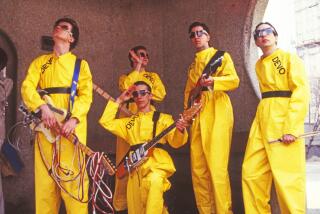Back to Woodstock
- Share via
Regarding “Still No Room for Grateful Dead Even in Relaxed-Fit ‘Woodstock,’ ” by Judy Brennan (Film Clips, June 26):
The Woodstock festival--the original and the repeats--are news and in the headlines, and to say the least I was disappointed in the article. For starters, of all the things Brennan and I spoke about as being important about “Woodstock” and what it relates to, approximately 119th--if it was even on the list--was the fact that the 40 minutes added to the film did not include the Dead.
Why did both of us waste so much of our time and end up with such nuts and bolts and trivia and irrelevancies?
Why not, for example, lead and emphasize free expression versus free enterprise? Surely these issues were near the top in importance on both our lists.
Even Crosby, Stills & Nash’s song “Long Time Comin’ ” (“Speak out against the madness / Speak your mind if you dare”) was twisted in the article’s opening to mean mindless numbers (it’s been a long time coming, 25 years, to putting in 40 minutes), totally eviscerating meaningful, important content.
I know all too well that the headline and opening paragraphs of a story are all important, but look what readers got: numbers and laundry lists. Where are culture, society, politics and so forth, which are what Woodstock is all about?
Is it that compared to the ‘60s, stories of the ‘90s emphasize negatives, not positives, and are written with the upper row of keys on the computer--the number keys: 40 minutes, $100 million, simple uncomplicated numbers. Forget positives and the 26 letter keys on the bottom rows. Forget philosophy and words; give ‘em the bottom line and numbers.
Peace & Music versus Peace & Music Inc. Is it the end of history? Is there only one ideology left? The number keys.
The Times and I and, far more important, the readers are the losers.
MICHAEL WADLEIGH
London
Wadleigh is the director of “Woodstock.”
In what was otherwise an excellent article chronicling the restoration and re-release of the 1969 documentary film “Woodstock,” Judy Brennan apparently did not check out her facts very thoroughly.
In her interview with supervising sound editor L.A. (Larry) Johnson, she says that “the original eight-track recording was put in a sonic solution,” as if the tapes had been dipped in a vat filled with some arcane and magical fluid, thereby cleaning and restoring the audio to pristine quality. This does a great disservice to both Johnson and my employer, Sonic Solutions.
Sonic Solutions is a developer of digital audio, digital video and high-speed networking systems for multimedia productions. The specific product that Johnson was referring to is NoNOISE, a very sophisticated computer-based noise removal and audio restoration system. NoNOISE was the first commercially available system of its kind and is used around the world to restore music recordings and film and video soundtracks.
LARRY DEEDS
Western North America
Sales Manager, Sonic Solutions
Hollywood
More to Read
Only good movies
Get the Indie Focus newsletter, Mark Olsen's weekly guide to the world of cinema.
You may occasionally receive promotional content from the Los Angeles Times.










